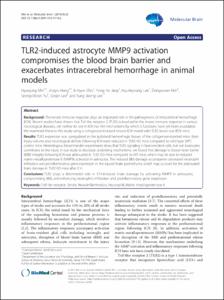TLR2-induced astrocyte MMP9 activation compromises the blood brain barrier and exacerbates intracerebral hemorrhage in animal models
- Title
- TLR2-induced astrocyte MMP9 activation compromises the blood brain barrier and exacerbates intracerebral hemorrhage in animal models
- Author(s)
- Min, Hyunjung ; Hong, Jinpyo ; Cho, Ik-Hyun ; Jang, Yong Ho ; Lee, Hyunkyoung ; Kim, Dongwoon ; Yu, Seong-Woon ; Lee, Soojin ; Lee, Sung Joong
- Issued Date
- 2015-04
- Citation
- Molecular Brain, v.8
- Type
- Article
- Author Keywords
- Toll-like receptor ; Stroke ; Neuroinflammation ; Neutrophil ; Matrix metalloproteinase-9
- Keywords
- FOCAL CEREBRAL-ISCHEMIA ; GLIAL-CELL ACTIVATION ; TOLL-LIKE RECEPTOR-4 ; SPINAL-CORD-INJURY ; MATRIX METALLOPROTEINASES ; NEUTROPHIL DEPLETION ; NEURONAL INJURY ; DENDRITIC CELLS ; RAT-BRAIN ; MOUSE
- ISSN
- 1756-6606
- Abstract
- Background: The innate immune response plays an important role in the pathogenesis of intracerebral hemorrhage (ICH). Recent studies have shown that Toll-like receptor 2 (TLR2) is involved in the innate immune response in various neurological diseases, yet neither its role in ICH nor the mechanisms by which it functions have yet been elucidated. We examined these in this study using a collagenase-induced mouse ICH model with TLR2 knock-out (KO) mice. Results: TLR2 expression was upregulated in the ipsilateral hemorrhagic tissues of the collagenase-injected mice. Brain injury volume and neurological deficits following ICH were reduced in TLR2 KO mice compared to wild-type (WT) control mice. Heterologous blood-transfer experiments show that TLR2 signaling in brain-resident cells, but not leukocytes, contributes to the injury. In our study to elucidate underlying mechanisms, we found that damage to blood-brain barrier (BBB) integrity following ICH was attenuated in TLR2 KO mice compared to WT mice, which may be due to reduced matrix metalloproteinase-9 (MMP9) activation in astrocytes. The reduced BBB damage accompanies decreased neutrophil infiltration and proinflammatory gene expression in the injured brain parenchyma, which may account for the attenuated brain damage in TLR2 KO mice after ICH. Conclusions: TLR2 plays a detrimental role in ICH-induced brain damage by activating MMP9 in astrocytes, compromising BBB, and enhancing neutrophils infiltration and proinflammatory gene expression. © 2015 Min et al.; licensee BioMed Central.
- Publisher
- BioMed Central Ltd.
- Related Researcher
-
-
Yu, Seong-Woon
- Research Interests Molecular mechanisms of neuronal cell death and neurodegeneration
-
- Files in This Item:
-
 기타 데이터 / 3.39 MB / Adobe PDF
download
기타 데이터 / 3.39 MB / Adobe PDF
download
- Appears in Collections:
- Department of Brain Sciences Laboratory of Neuronal Cell Death 1. Journal Articles



